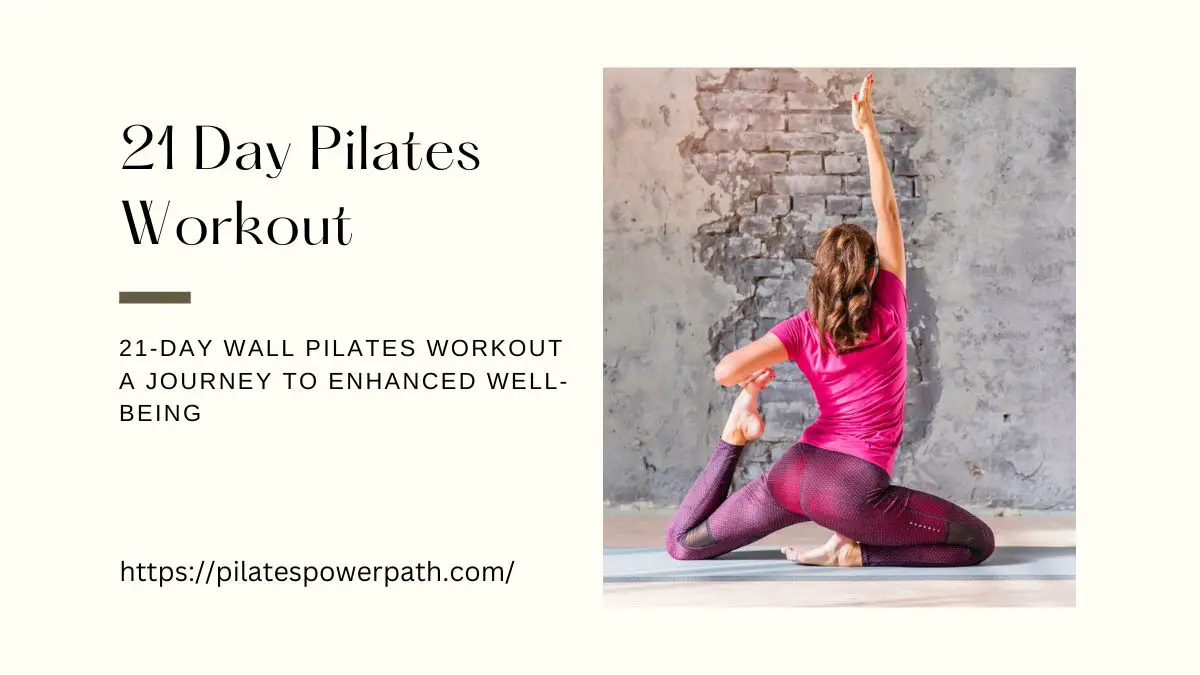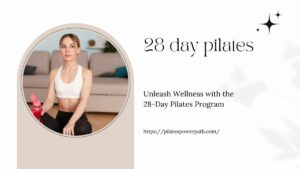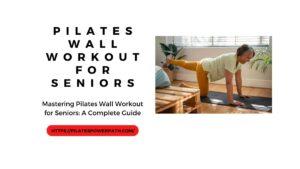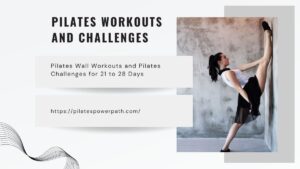21-Day Wall Pilates workout, a physical fitness system developed in the early 20th century by Joseph Pilates, has grown in prominence due to its emphasis on balance, flexibility, and core strength. As a low-impact exercise designed to strengthen muscles while improving postural alignment and flexibility, Pilates can be a transformative addition to your fitness routine.
Traditionally practiced on a mat or with specialized equipment, Pilates can also be performed using a wall. Wall Pilates leverages the wall as a supportive tool, enabling a greater range of movement and offering enhanced balance and stability. It opens up opportunities for new exercises and can make Pilates more accessible to beginners or those with mobility issues.
The purpose of this 21-Day Wall Pilates Workout Challenge is to make a consistent, committed effort toward transforming your core strength and overall physical fitness. Over 21 days, you’ll immerse yourself in the Wall Pilates method, exploring a variety of exercises to increase muscular strength, boost flexibility, and improve balance. With dedication and persistence, you’ll witness a transformation not just in your physical appearance, but also in your mental well-being and resilience
Foundation Building
Understanding the Basics of Wall Pilates
Before we delve into our 21-day workout, it’s crucial to establish a solid foundation by understanding the basics of Wall Pilates. Wall Pilates, as the name suggests, incorporates the use of a wall as a tool to enhance the effectiveness of traditional Pilates exercises. This novel approach allows for greater control and stability, opening up a new realm of exercises that can help improve your core strength, flexibility, and balance.
Introduction to essential wall Pilates exercises
One of the key components of Wall Pilates is the introduction to essential exercises. These exercises, which will become a staple in your 21-day challenge, are designed to engage your core muscles, improve your posture, and boost your strength and flexibility. They include movements like the Wall Roll-Down, Wall Squats, and Wall Push-Ups, each providing unique benefits and targeting specific muscle groups.
Importance of correct posture and alignment
With Wall Pilates, correct posture and alignment are paramount. The wall provides a physical guide for maintaining alignment, ensuring that your spine stays straight and your body is properly positioned throughout each exercise. This focus on alignment not only enhances the effectiveness of the workout but also helps to prevent injury. By emphasizing correct posture, Wall Pilates promotes a greater awareness of your body, which will enrich your overall Pilates experience and contribute to your physical transformation throughout this 21-day challenge.
Read More: Unleash Your Potential with the 21-day Pilates wall workout chart
Core Activation and Stabilization
The crux of any Pilates workout, including Wall Pilates, lies in the activation and stabilization of the core muscles. Engaging the core not only works the muscles in your abdomen, but also includes the muscles in your lower back, hips, and pelvis. Ensuring these muscles are activated is important in maintaining stability and control during each Wall Pilates exercise.
Core Engagement Techniques Using the Wall
Wall Pilates incorporates specialized techniques to help engage your core. For instance, the Wall Slide requires you to press your back against the wall while performing a sliding motion. This engages your core and tests your stability. Likewise, the Wall Plank, another core engagement exercise, involves placing your hands on the wall and extending your feet backward into a plank position. These exercises, among others, will help activate your core muscles and improve your stability.
Incorporating Breathing Patterns for Optimal Results
Breathing plays a pivotal role in Pilates, and Wall Pilates is no exception. Correct breathing helps to focus your mind, oxygenate your muscles, and ensure proper form. The recommended breathing pattern for Wall Pilates involves inhaling deeply through the nose while expanding the ribcage, and exhaling fully through the mouth while contracting the abdominal muscles. This conscious, controlled breathing not only helps you perform each exercise with maximum efficiency but also instills a sense of calm and relaxation. Throughout this 21-day workout, you’ll learn to use breathing as a tool to enhance your workouts and optimize your results.
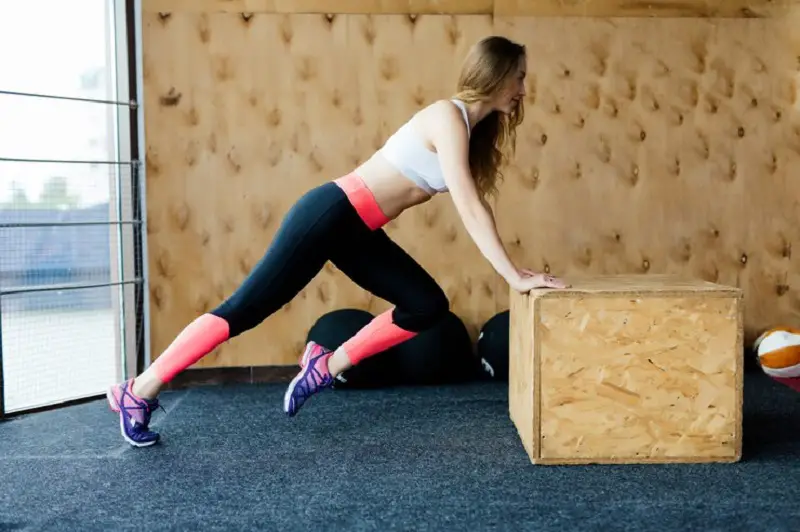
Progressive Strengthening
Advancing foundational exercises with variations
As you progress through the 21-Day Wall Pilates Workout Challenge, increasing the intensity of your workouts will be key to achieving noticeable results. One method of doing this is through variations on foundational exercises. Variations can add complexity, challenge your muscles in new ways, and prevent your routine from becoming monotonous. For example, you might experiment with different leg movements in the Wall Plank, or incorporate an exercise ball into your Wall Squats.
Exploring different angles and positions against the wall
Exploring different angles and positions against the wall is another useful strategy for progressive strengthening. This can introduce new challenges to your workout, further engage your core, and promote increased strength and flexibility. Consider changing the angle between your body and the wall during Wall Push-Ups, or experimenting with lateral movements in the Wall Slide. As you continue to push your boundaries, always remember to maintain correct posture and alignment, and to match your movements with your breath for optimal results.
Enhancing Flexibility and Balance
Flexibility and balance are integral elements of Pilates that promote overall fitness and prevent injuries. Incorporating stretching exercises into your Wall Pilates routine helps to increase flexibility, enhance muscle function, and improve range of motion. Regular stretching also aids in post-workout recovery, alleviates muscle tension, and contributes to a sense of well-being.
Integrating stretching and balance exercises
Balance exercises, such as the Wall Leg Lifts or Wall Tree, are just as important. They challenge your stability, engage your core muscles, and help to improve your coordination and body awareness. Training balance isn’t only beneficial for your Pilates practice, but it also translates into improved performance in other physical activities and helps with day-to-day tasks.
Benefits of combining flexibility with core strength
The combination of flexibility and core strength is a powerful one. While flexibility allows your body to move freely and fluidly, core strength provides the support for those movements. This interplay is at the heart of Wall Pilates. It allows you to perform exercises with greater efficiency and precision, reduces the risk of injuries, and leads to improved posture and alignment. By the end of the 21-day challenge, you’ll notice increased flexibility and balance, underpinned by a strong, stable core.
Mastery and Refinement
Fine-Tuning Technique and Precision
In the mastery and refinement phase of your Wall Pilates journey, attention to detail becomes paramount. This phase is about fine-tuning your technique and honing the precision of movements.
Focusing on Form and Precision in Movements
In Wall Pilates, as in all forms of exercise, it’s not about how many repetitions you can do, but how well you perform each one. By focusing on form and precision in movements, you ensure that you’re engaging the right muscles while minimizing the risk of injury. For instance, when performing a Wall Plank, keep your body in a straight line, engage your core, and avoid allowing your hips to sag. It’s this attention to detail that will help you reap the full benefits of Wall Pilates.
Adjustments for Better Effectiveness and Safety
No matter your fitness level, adjustments may be needed to make the most of your Wall Pilates routine. Small changes can have a significant impact on the effectiveness and safety of your workouts. For example, in a Wall Push-Up, if you notice strain in your neck or shoulders, adjust your hand position or the angle of your body to the wall. Always listen to your body; if a position or movement causes discomfort or pain, make adjustments or consult with a fitness professional. Remember, Wall Pilates is about progressing at your own pace, prioritizing form over speed, and continuously refining your technique for optimal results.
Challenge Yourself with Advanced Wall Pilates
As you become more comfortable with the foundational exercises in the Wall Pilates 21-day workout, it’s time to push your fitness boundaries further by introducing more challenging exercises. These can range from exercises that require more strength, like Advanced Wall Planks, to ones that demand increased balance, like the Wall Supported Tree with a Twist. Remember, these advanced moves may take time to master, but they offer the chance to further enhance your strength, flexibility, and body awareness.
Introducing more challenging exercises
Innovation and variety can keep your Wall Pilates practice engaging and challenging. Advanced exercises may include variations on the original exercises, incorporating props like exercise balls or resistance bands, or perhaps trying exercises that challenge your balance and flexibility in new ways. These advanced movements will not only increase the intensity of your workouts but also target different muscle groups, promoting full-body strength and fitness.
Celebrating progress and accomplishments
The journey through Wall Pilates is not just about the destination, but also about celebrating each milestone along the way. Whether you’ve mastered a new exercise, noticed an improvement in your flexibility, or simply completed your 21-day workout, each achievement deserves recognition. Celebrating these moments can serve as motivation to keep pushing forward and remind you of the progress you’ve made. So, take the time to reflect on your journey, applaud your accomplishments, and prepare for the next phase of your Wall Pilates adventure.
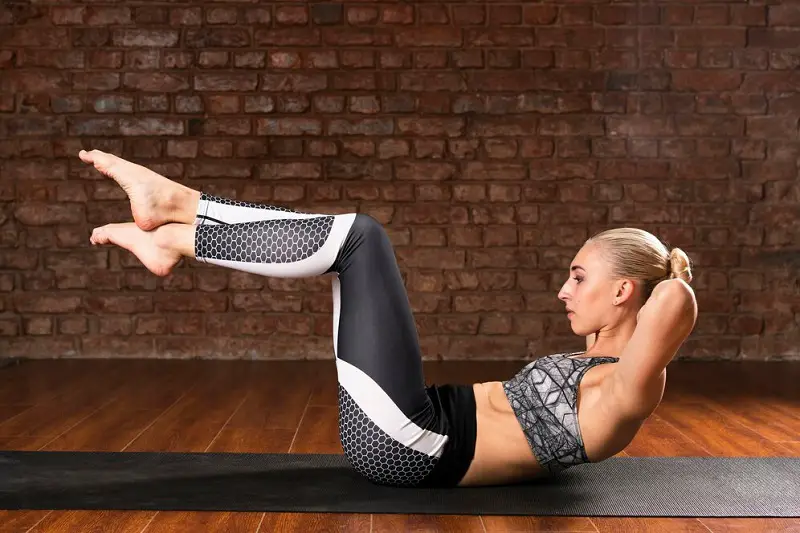
Benefits of the 21-Day Wall Pilates workout
The 21-Day Wall Pilates workout offers a multitude of benefits, each contributing to your overall health and well-being.
Improved Core Strength and Stability
By focusing on the use of your abdominals, lower back, hips, and pelvic floor, Wall Pilates significantly improves your core strength and stability. This is vital not only for overall fitness but also for improving performance in other physical activities and reducing the risk of injuries.
Enhanced Posture and Alignment
Wall Pilates workout emphasizes the importance of proper posture and body alignment. The wall provides tactile feedback, helping you align your body correctly during each exercise. As a result, you can expect to see an improvement in your posture and body alignment, which will translate to your everyday life, helping to reduce the occurrence of back pain and other postural issues.
Increased Flexibility and Balance
The stretching and balance exercises that are an integral part of Wall Pilates help to increase flexibility, enhance muscle function, and improve your range of motion. Over time, you’ll also notice an improvement in your balance, which is vital for preventing falls and maintaining your independence as you age.
Mental Focus and Mind-Body Connection
Finally, just like traditional Pilates, Wall Pilates enhances your mental focus and strengthens the mind-body connection. By requiring you to focus on your breathing and the precision of your movements, Wall Pilates helps to increase your awareness of your body, leading to better movement patterns and a greater sense of well-being.
Tips for Success
Consistency and Commitment to Daily Practice
Consistency is key in any fitness regimen, and Wall Pilates is no exception. Committing to daily practice will help you build strength, improve flexibility, and enhance your form and technique over time. Try to set a specific time of day for your workout to create a routine. Remember, the goal isn’t perfection but progression. Each day you dedicate to Wall Pilates brings you one step closer to your fitness goals.
Listening to Your Body and Adjusting Intensity as Needed
While it’s important to push yourself, it’s equally crucial to listen to your body cues. If an exercise feels too intense or causes discomfort, it’s okay to modify or take a break. Wall Pilates is about facilitating your body’s natural movement patterns, not forcing them. Adjust the intensity of your workouts as needed, and remember, it’s about quality, not quantity.
Proper Nutrition and Hydration to Support Workouts
To maximize the benefits of your Wall Pilates routine, ensure you’re fueling your body properly. This means following a balanced diet rich in lean proteins, whole grains, fruits, and vegetables, as well as keeping yourself hydrated. Water is vital for muscle function and recovery, so make sure you’re drinking enough before, during, and after your workouts.
Rest and Recovery as an Integral Part of the Challenge
Rest and recovery are essential components of any fitness challenge. Your muscles need time to repair and rebuild after workouts. Ensure you’re getting enough sleep, and consider incorporating gentle restorative activities into your routine, such as yoga or meditation. Remember, rest days are not days off—they are just as important as workout days in your Wall Pilates journey.
Conclusion
The journey of the 21-day Wall Pilates workout is an exciting and transformative one. Each day brings a new exercise, a new workout, and with it, a new opportunity to improve strength, flexibility, and balance. The progression from basic to more advanced exercises allows you to continuously challenge yourself and keep your workouts interesting and engaging.
Incorporating Wall Pilates into your daily routines can have a profound impact on your health and well-being. The benefits extend beyond improved physical fitness to include enhanced mental focus and a stronger mind-body connection. With consistent practice, you’ll start to see improvements not just in your workouts, but in your everyday life.
The beauty of Wall Pilates, and indeed any fitness journey, lies in the fact that it’s an ongoing process. Even after the 21-day workout, there’s always room to continue growing, learning, and improving. So, keep pushing, keep striving, and remember, every small progress is a step towards achieving your fitness goals. Yes, the journey may be challenging at times, but it’s also immensely rewarding. So, stay committed, stay consistent, and most importantly, enjoy the journey!
Frequently Asked Questions
Yes, the 21-Day Wall Pilates Challenge is designed to accommodate all fitness levels, including beginners. The exercises progress from basic to more advanced, allowing you to build strength, flexibility, and balance gradually. Always remember to listen to your body and adjust the intensity of the workouts as needed.
The time commitment will vary depending on the specific exercises and your fitness level. However, it’s recommended to allocate around 20-30 minutes daily for your Wall Pilates routine. Consistency is key to seeing improvements in your strength, flexibility, and overall fitness.
No special equipment is required for Wall Pilates. All you need is a sturdy wall to act as your support during the exercises. However, using a mat for comfort and to prevent slipping is beneficial, especially when performing exercises on the floor.

